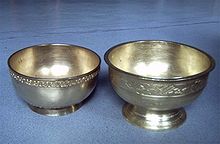The Banjar or Banjarese (Urang Banjar in Banjarese language; اورڠ بنجر in Jawi script) are a native ethnic group in South Kalimantan, Indonesia. Several centuries ago, some of them had travelled to many places in the Malay archipelago. They set up pockets of settlement there, in Perak (mostly in Bagan Serai, Parit Buntar, Sungai Manik and Teluk Intan), Selangor around (Sabak Bernam, Sekinchan, Sungai Besar and Tanjung Karang), in Johor (Batu Pahat), in Singapore as well as other places.
History
The Proto-Malay people migrated to Borneo in 2500 BC. They were the ancestors of theDayak people (Ot Danum people). In 2500 BC, the Deutero Malays migrated to Borneo. TheMalay people from Sumatra brought their culture to Borneo in 400 AD. The fusion of the cultures saw the birth of the Upper Banjar language (Bahasa Banjar Hulu). Later, in 520 AD, the Malays formed the Buddhist Kingdom of Tanjungpuri in the present-day region ofTanjung, Tabalong.
In 1200 AD, Empu Jatmika built the Hindu Kingdom of Negara Dipa by the river of Tapin. This was the start of the Javanese-style courts in South Kalimantan. The Hindu era in South Kalimantan remained the most remembered period in South Kalimantan's history. The glory of Negara Dipa was succeeded by the Hindu Kingdom of Negara Daha in 1400 AD.
According to history, Prince Samudera, the rightful heir to the kingdom of Negara Daha, was forced to flee the court of because of his uncle's revolt against him. He was accepted by the people of Bandar Masih (Bandar: port, Masih: Malay people). Supported by the Sultanate of Demak, he formed a new Islamic Banjar Kingdom in 1526 with Bandar Masih as its capital. The name of Bandar Masih was later changed to its present name Banjarmasin.
Since the 19th century, migration of the Banjarese people went as far as the east coast of Sumatra and Malaysia. In Malaysia, Banjarese people are classified as part of the Malay race.
Sub-ethnicities
The division of Banjar people into 3 ethnicities is based on the locations of the assimilation between the Malays, the local Dayaks(Dayak Bukit, Dayak Ma'anyan, Dayak Lawangan, Dayak Ngaju, Dayak Barangas, and Bakumpai), and the Javanese people.
- The Banjar Pahuluan, who live in the valleys by the upriver of Meratus mountain ranges. They make their living from agriculture.
- The Banjar Batang Banyu, who live in the valleys by the river of Negara. They are proud of their position as the people of the ancient capital. They are also prominent merchants.
- The Banjar Kuala, who live in Banjarmasin and Martapura. They are the people of the new capital.
Language
The Banjar language (bjn) reflects the history of people. It is basically the Malay language brought from Sumatra, with some words that are taken from Javanese and the native Dayaks.
Relations with Dayaks
The relationship between Banjar people and the neighbouring Dayaks have always been good. Some of theDayaks who had converted to Islam have also assimilated into the Banjar culture and call themselves Banjar. The Dayaks also think of the Banjars as their brothers and sisters. This is further strengthened by the fact there are many inter-marriages between the Banjars and the Dayaks, even among the members of the royalty. For example, Biang Lawai, a wife of a Banjar king was of Dayak Ngaju ethnicity. This means that the Banjarese Kings and Queens have Dayaks lineage in their blood.
This relationship grew strong when both ethnicities faced colonisation by the Dutch in the 18th century. They became comrades in an age of war. Some of the warriors involved in Banjar War are of Dayak ethnicity or have Dayaks lineage in their blood. For example:
- Panglima Batur, who was of Dayak Siang Murung ethnicity,
- Panglima Wangkang, whose his father was a Dayak Bakumpai and whose mother was a Banjar,
- Panglima Batu Balot (Tumenggung Marha Lahew), a female warrior who attacked Fort Muara Teweh in 1864-1865.










That’s a picture of balinese people, not banjar people! Ida ketoet is a name of brahmin caste from bali, and punggawa also the title of nobility from bali, not from banjar of borneo. Please change the picture
ReplyDelete